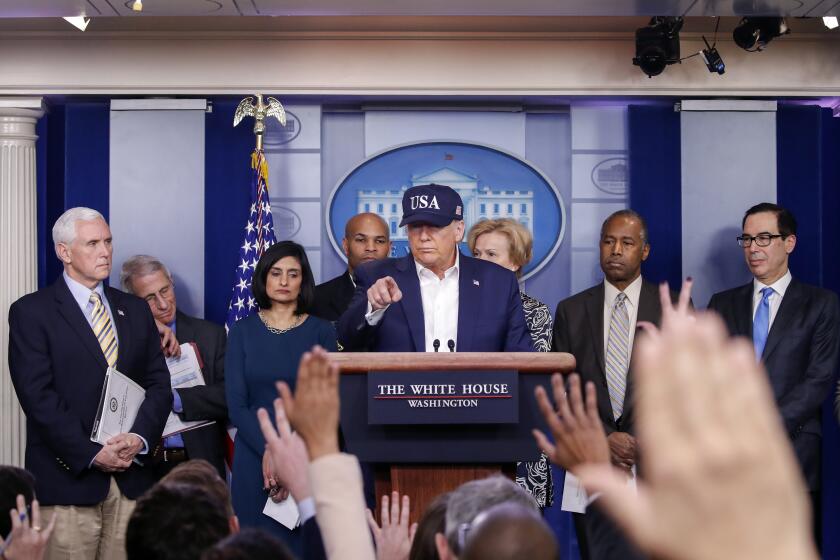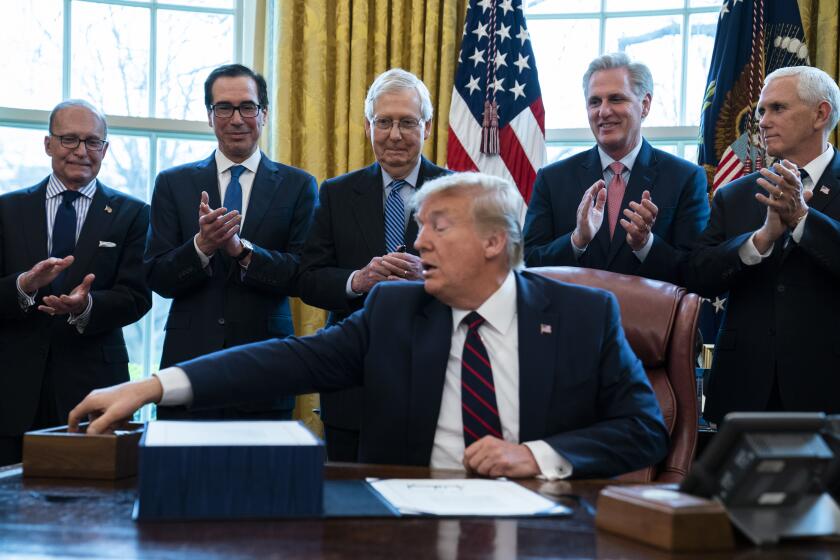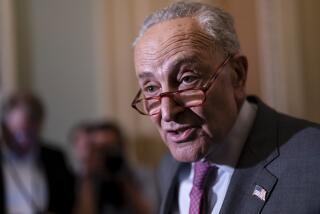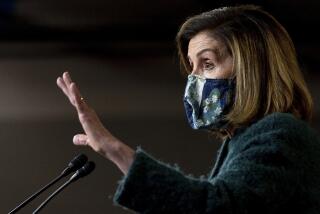Column: The next coronavirus rescue bill must fix all the problems of the last one
Even as Congress was debating its third coronavirus rescue plan -- the $2-trillion CARES Act eventually signed by President Trump on March 27 -- it was assumed that a follow-up measure would be necessary to forestall an extended economic downturn.
The moment to assemble that measure is now upon us, with the House reconvening Thursday in a continued atmosphere of national crisis. That makes the question of what should be in the bill especially urgent.
1. Get more money out ... The first imperative is to ensure that there is sufficient federal assistance to meet the needs of furloughed and laid-off workers, employers, and creditors such as landlords.
We should never be in a position of getting hit like this and have to scramble to respond again.
— Dr. Anthony Fauci
Congressional Republicans seem to be alive to this necessity. Senate Majority Leader Mitch McConnell (R-Ky.) is already on record stating that the Senate is prepared to enact an additional $250 billion for the so-called Paycheck Protection Program -- loans to small businesses that can be turned into outright grants to the extent the businesses keep workers on their payroll.
It was evident virtually from the start that the $350 billion allocated for this program in the CARES Act wouldn’t be sufficient. As George Washington University economist Steven Hamilton calculates, firms with fewer than 500 employees spend about $2.7 trillion on payroll per year, or $600 billion in the 2 1/2 months covered by the CARES Act loans. But the act only provides about $376 billion for that period
The mismatch is visible in the tsunami of loan applications that hit the banking system starting Friday, the day applications were first accepted by commercial banks, as businesses rushed to get their requests in promptly before funding for the first-come-first-served program ran out. Even the biggest banks were swamped. As of Wednesday, Bank of America says it has received 250,000 applications seeking a total of $40 billion.
A public health expert shares how to crush the virus. But we’re way behind.
The same goes for the stimulus payments of up to $1,200 per adult, for which those earning $90,000 or less are eligible. That funding will fall short if shelter-in-place rules lead to furloughs and layoffs, although the four-month bump of $600 per week in unemployment benefits, on top of maximium state benefits, will help.
Many households are facing bills that must be paid, including rent and credit card payments. “As helpful as the CARES Act is, it is very likely that the US will need a bigger boat when it comes to federal support,” observed investment banker and Cornell business professor Daniel Alpert in Business Insider op-ed on April 1.
2. ... but the way the money is disbursed matters. Funneling the small business loans through the banking system underscores how ill-prepared the federal government has been to deliver emergency assistance.
Although the banks were theoretically excused from validating applicants’ representations about their payrolls -- the factor determining their maximum loans -- rules issued by the Treasury Department last Thursday, the day before the application process was launched, said the banks would be held to anti-money laundering standards and anti-fraud know-your-borrower regulations.
That threw sand in the gears of the Paycheck Protection Program. Commercial banks responded initially by giving priority to their business borrowers, ahead of business clients with merely savings or checking accounts. Some banks have relaxed those prerequisites, but the process left many small businesses without options.
It didn’t have to happen this way. Contrast the American approach with Denmark’s, where the government is directly covering 75% of worker wages up to about $3,400 per month, with employers covering the rest, on condition the employers don’t fire the employees.
Given the additional proposed appropriation for the Paycheck program, Congress will have appropriated $600 billion for small businesses. There’s little justification for using the banking system to disburse this assistance, given the welter of rules and regulations that govern their operations.
It’s also important to insulate Social Security revenues from the coronavirus assistance programs. To a certain extent, the horse has left that barn: The CARES Act allows businesses to defer paying their share of Social Security taxes to the government for up to two years, rather than monthly or semiweekly, as is customarily required.
President Trump’s hype of a potential treatment for COVID-19 gives false hope to virus patients and causes real harm to others.
More worrisome is President Trump’s push to give employees a payroll tax holiday. We’ve explained before how this idea would fail to provide significant assistance to many families and would unnecessarily undermine the finances of Social Security. Trump is still noodling with it, however.
At a press briefing Wednesday he pushed it again, stating that “it would be quick” and would “help a lot of people.” He’s wrong on both counts. The gain would be diluted over time, and it would do nothing for those out of work since they’re not paying the tax anyway.
More frightening, Trump said he’s in favor of cutting the payroll tax even absent the coronavirus crisis. This places him squarely in the right-wing camp that has been striving to destroy Social Security since its inception in 1935. Democrats must stand fast against the scheme.
3. Get Trump’s hands off the bailout oversight. Trump stated even as he signed the CARES Act that he would not allow the congressional and public oversight written into the bill at Democrats’ insistence to go forward without his interference.
He has already made good on that threat. On Tuesday, he demoted the Defense Department’s acting inspector general, Glenn Fine, after Fine had been named by a committee of inspectors general to the post of overseer of the coronvirus bailout. The action made Fine no longer eligible to serve as overseer.
The action reflect’s Trump’s general disdain for oversight of his actions, but it’s especially key now, since without public scrutiny the chances are magnified that bailout funds will go to the president’s cronies or members of his family. The pressure is now on Democrats to immunize public oversight from Trump’s interference as part of the next bill.
Trump says he won’t cooperate with bailout oversight, so what is he hiding?
4. Create a single-payer system for all COVID-19 patients. The cost of treating COVID-19, the disease caused by the pandemic coronavirus, is a moving target at this stage. The Kaiser Family Foundation estimates that 2% to 7% of America’s uninsureds will require hospitalization for the disease, or 670,000 to about 2 million patients.
This will place a huge burden on hospitals treating uninsured patients. The administration says it will pay hospitals for their uncompensated care at Medicare rates out of the $100 billion allocated for healthcare providers in the CARES Act, but it has issued no specifications for that aid.
Even if that assistance were adequate, that still leaves the costs shouldered by insured and underinsured patients in the form of deductibles, co-pays and other coverage limits. The prospect of big bills could discourage many infected Americans from seeking care, posing greater disease risks to themselves, their families and friends and their communities.
There’s a precedent for the government stepping in as the single-payer for this disease. It’s end-stage renal disease, for which the government can be billed for all dialysis costs through Medicare, regardless of the patient’s age. (Medicare typically covers Americans over the age of 65.) The program was instituted by Congress in the 1970s, when kidney patients were systematically excluded from health insurance plans.
Today, with an implacable disease threatening not only its immediate victims but public health in general, the need to ensure that everyone can be treated is even more urgent. Democrats have proposed funneling this assistance through either Medicare or Medicaid. It should be in the next bill.
5. Look ahead to addressing the long-term consequences of COVID-19 and the shutdown. The pandemic has shined a spotlight on the shortcomings of America’s economic system, its healthcare infrastructure and its electoral process, among many other issues. It’s not too early to start addressing them all.
New statistics are beginning to show that COVID-19 is exacting an appallingly disproportionate toll on low-income and minority communities. In Los Angeles County, black residents have accounted for 17% of COVID-19 deaths although they constitute only 9% of the population.
But those are incomplete figures. In other communities the differences are starker. In Michigan, for example, African Americans account for 14% of the population but 33% of COVID-19 cases and 41% of deaths.
It’s time to think about how to get workers raises over the long term.
The discrepancies may be due to several factors. African Americans have poorer health profiles than the general population, including higher rates of diabetes and high blood pressure. Low-income neighborhoods tend to be closer to sources of air pollution, which exacerbate pulmonary problems such as asthma.
These are all conditions that could make them more vulnerable to COVID-19, and point to chronic inequalities in American healthcare that demand to be fixed.
America’s public health infrastructure has been deteriorating for decades. In part the system has been a victim of its success at containing infectious diseases through vaccines and therapeutic treatments, as Anthony Fauci, head of the National Institute of Allergy and Infectious Diseases, said in a video conversation posted by the Journal of the American Medical Assn. on Wednesday.
“We’ve let it slip,” Fauci said. “Boy, if this should be a lesson for the future, I hope that when we get out of this ... we do take a really good look at the long-term investments for the future in the public health infrastructure,” including state and local public health services. “We should never be in a position of getting hit like this and have to scramble to respond again.”
Finally, voting. The spectacle of Wisconsin residents lining up in person to vote Tuesday is a reproach to America’s outdated electoral system and the lack of voting by mail. Republican insistence on in-person voting in Wisconsin is openly the result of fears of Democratic turnout, as Trump himself acknowledged Wednesday.
“For whatever reason,” he tweeted, mail-in voting “doesn’t work out well for Republicans.” Voting methods shouldn’t be permitted to be a partisan issue, especially when voters are forced to chose between casting their ballots and subjecting themselves to health risks. With a presidential election only seven months away, nationwide mail-in voting deserves to be in the next bill.











